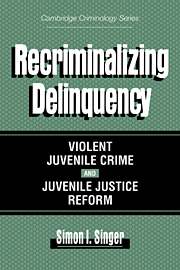Book contents
- Frontmatter
- Contents
- List of Figures and Tables
- Acknowledgments
- Introduction
- 1 Recriminalizing Violent Juvenile Crime
- 2 Taking Stock of Juvenile Justice Reforms
- 3 Recriminalization on the Move and Its Legal Rules
- 4 Contextual and Legal Reasons for Identifying Juveniles as Criminal Offenders
- 5 The Case Processing of Juvenile Offenders: From Arrest to Disposition
- 6 Recriminalization and Organizing for Deterrence
- 7 Convicted Juvenile Offenders in a Maximum Security Institution
- 8 Concluding “Real” Reasons for Recriminalizing Delinquency
- Appendixes
- Notes
- References
- Index
3 - Recriminalization on the Move and Its Legal Rules
Published online by Cambridge University Press: 29 September 2009
- Frontmatter
- Contents
- List of Figures and Tables
- Acknowledgments
- Introduction
- 1 Recriminalizing Violent Juvenile Crime
- 2 Taking Stock of Juvenile Justice Reforms
- 3 Recriminalization on the Move and Its Legal Rules
- 4 Contextual and Legal Reasons for Identifying Juveniles as Criminal Offenders
- 5 The Case Processing of Juvenile Offenders: From Arrest to Disposition
- 6 Recriminalization and Organizing for Deterrence
- 7 Convicted Juvenile Offenders in a Maximum Security Institution
- 8 Concluding “Real” Reasons for Recriminalizing Delinquency
- Appendixes
- Notes
- References
- Index
Summary
the motivation to recriminalize delinquency was not merely a consequence of the ideological bent of several conservative critics of juvenile justice. U.S. Supreme Court judges and distinguished scholars on the President's Crime Commission contributed their share of criticism. By the mid-1970s, public and official complaints about juvenile justice once more threatened the system's political and moral legitimacy. In New York, the stage was set for recriminalization in the shape of its JO law.
The immediate sources of crisis and the legal response at this point will be examined more closely; they are directly related to the manner in which New York was able to create and implement its unique form of recriminalization. I will examine the political and organizational steps leading to the JO law in the way of media stories, an earlier reform, legislative committee reports, and the debates that preceded the JO law.
By media stories I do not mean that they were unrelated to reality. Rather, they presented a version of reality that fit a recurring popular media theme of violent juvenile crime and juvenile justice. They stressed that a segment of delinquents was more violent and more chronic than the delinquents of earlier generations. At the same time, they argued that the juvenile justice system failed to keep up with the more violent behavior of this new generation of violent delinquents. In highlighting the problem of juvenile crime and justice, media stories set the stage for commission reports recommending legal reform.
- Type
- Chapter
- Information
- Recriminalizing DelinquencyViolent Juvenile Crime and Juvenile Justice Reform, pp. 46 - 74Publisher: Cambridge University PressPrint publication year: 1996

